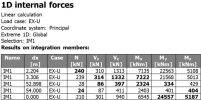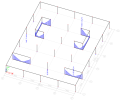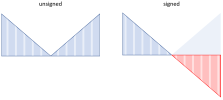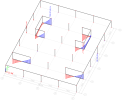Seismic modal superposition and resultants in SCIA Engineer
Background
Seismic modal superposition is a method based on statistics theory and fundamentally generates only positive values (see "Seismic loading: Modal superposition").
Typically, unsigned seismic results at the bottom of a building look like this:
Such results are not usable directly to compute resultant forces in a shear wall or in a core.
In the example above, the expected magnitude of the main results for seismic action in X direction are Rx = ~1'300 kN, Rz = 0 kN, My = ~24'600 kN
Instead, the obtained values for the resultant of support reactions are Rx = 1'585 kN, Rz = 10'312 kN, My = 1'670 kN
The result for Rx is more or less acceptable, but completely off for Rz and My.
There are two possibilities for obtaining meaningful values of resultants from a seismic load case.
Modal pre-superposition using signed results
As shown above, the typical distribution of vertical stress in a shear wall under horizontal loading is quasi-linear and antimetric. Because of its formulation, all results of a seismic load case just after modal superposition are unsigned, leading to a symmetrical diagram. Computing resultant forces from such a diagram produces a quasi-zero overturning resulting moment and a much overestimated resulting vertical force.
In order to obtain meaningful resultant forces and moments, the results must be signed. Signed results may be obtained by selecting a predominant mode in the seismic load case settings (see signed results in "Seismic load case settings"). This is possible in case a mode is clearly predominant for the selected seismic action direction:
In such a case, signed results typically look like this:
The associated resultant forces and moments are listed above. The magnitudes of the values clearly make more sense. The resulting shear force (Rx) changes little (~15%) because the correct result for shear implies that all local stress values have the same sign.
The obtained values remain, however, approximations, as they are computed from envelope values of local results.
| Case | Rx [kN] | Rz [kN] | My [kNm] |
| Unsigned | 1'586 | 10'312 | 1'670 |
| Signed | -1'375 | -73 | -26'367 |
The method described above is so-called modal pre-superposition, i.e. modal superposition is performed on local results and post-treatment, such as calculation of resulting forces, is applied afterwards on superposed local results. That method is still used in in SCIA Engineer for the calculation of Resultant of reactions.
About signed results, see also:
Modal post-superposition
Another method, called modal post-superposition, consists of applying post-treatment to local results first for each eigenmode and perform modal superposition only afterwards, e.g. on resultant forces.
Essentially, it means computing the desired resultant forces separately for each mode and applying modal superposition afterwards. Doing so, signed results are not necessary to obtain meaningful resulting forces.
As a consequence, that method will return correct resulting forces also for unsigned seismic load cases, in absolute value. Additionally, signed results can be used with the method, providing then signed resulting forces.
Modal post-superposition is used in all result service in SCIA Engineer except Resultant of reactions. That includes:
- Seismic load case summary tables in linear calculation protocol


- Resulting forces in Detailed storey results


- Integration strip and integration member results


- Resultants from section on 2D members (that type of results does not take 1D members into account, which is why no sample results are shown here for the proposed example).
The table below compares the various possibilities for obtaining resulting forces at the bottom of the structure. The values from the calculation protocol are used as reference, as they are strictly based on the theoretical background equation and are computed directly from modal participation factors (see theory in "Seismic loading: Mathematical formulation & Calculation protocol"). For Rz, calculation protocol values are not available. Detailed storey results values (from FEM results at finite element center point) are used as next best reference.
| Result type | Case | Rx [kN] | Rz [kN] | My [kNm] | |||
| Resultant of reactions | Unsigned | 1'586 | +21.0% | 10'312 | +4'696.3% | 1'670 | -93.2% |
| Signed | -1'375 | +4.9% | -73 | -66.0% | -26'367 | +7.2% | |
| Calculation protocol | Unsigned | 1'311 | ref | n/a | n/a | 24'601 | ref |
| Signed | 1'311 | ref | n/a | n/a | -24'601 | ref | |
| Detailed storey results | Unsigned | 1'313 | +0.2% | 215 | ref | -24'172 | -1.7% |
| Signed | 1'313 | +0.2% | -215 | ref | 24'172 | -1.7% | |
| Integration member | Unsigned | 1'332 | +1.6% | 240 | +11.6% | 24'557 | -0.2% |
The method described above is so-called modal post-superposition, i.e. modal superposition is performed on final results, after computing them separately for each mode shape. That method is used in SCIA Engineer in calculation protocol, detailed storey results, resultants from section on 2D members, integration strip and integration member results.
Summary
- DO NOT use Resultant of reactions for unsigned seismic load cases or load case combinations or result classes that contain such load cases
- Resultant of reactions may be used with signed seismic load cases or load case combinations or result classes that contain such load cases, provided that proper signature is possible (see "Seismic load case settings")
- In general, prefer using other result services to obtain seismic resulting forces, such as
- summary table of seismic load cases in linear calculation protocol
- resulting forces per storey from detailed storey results
- resultant from section on 2D members (in case 1D members are not needed in the resultant)
- integration strip results (only for single 2D members)
- integration member results







